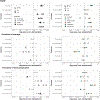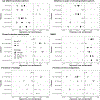Union formation, within-couple dynamics, and child well-being: A global macrolevel perspective
- PMID: 37635738
- PMCID: PMC10454532
- DOI: 10.1002/psp.2661
Union formation, within-couple dynamics, and child well-being: A global macrolevel perspective
Abstract
Studies on global changes in families have greatly increased over the past decade, adopting both a country-specific and, more recently, a cross-national comparative perspective. While most studies are focused on the drivers of global changes in families, little comparative research has explored the implications of family processes for the health and well-being of children. This study aims to fill this gap and launch a new research agenda exploring the intergenerational implications of union-formation and within-couple dynamics for children's health and well-being across low- and middle-income countries (LMICs), both globally, regionally, and by the stage of fertility transition. We do so by adopting a macro-level perspective and a multi-axis conceptualization of children's outcomes - health at birth, health in later life, and schooling - and leveraging Demographic and Health Survey and World Bank data across 75 LMICs. Our results show that in societies where partnerships are characterized by more equal status between spouses - i.e., where the age range between spouses and differences in years of schooling between partners are narrower - children fare better on several outcomes. These associations are particularly strong in mid- and high-fertility settings. Despite a series of regularities, our results also highlight a set of findings whereby, at a macro-level, the prevalence of marriage and divorce/separation are not invariably associated with children's outcomes, especially in LMICs where fertility is comparatively lower. We document little cross-regional heterogeneity, primarily highlighting the centrality of demographic factors such as age vis-à-vis, for instance, region-specific characteristics that are more tied to the social fabric of specific societies.
Keywords: LMICs; child outcomes; family change; gender dynamics; macro-level analyses; union formation.
Figures





References
-
- Abufhele A, Pesando LM, and Castro Torres AF (2022). Parental educational similarity and inequality implications for infant health in Chile: Evidence from administrative records, 1990–2015. Research in Social Stratification and Mobility 82:1–14.
-
- Barbieri M and Hertrich V (2005). Age difference between spouses and contraceptive practice in Sub-Saharan Africa. Population 60(5–6):617–654.
-
- Behrman JA (2019). Contextual Declines in Educational Hypergamy and Intimate Partner Violence. Social Forces 97(3):1257–1282.
-
- Behrman JA (2020). Mother’s Relative Educational Status and Early Childhood Height-for-Age z Scores: A Decomposition of Change Over Time. Population Research and Policy Review 39(1):147–173.
Grants and funding
LinkOut - more resources
Full Text Sources
Miscellaneous
